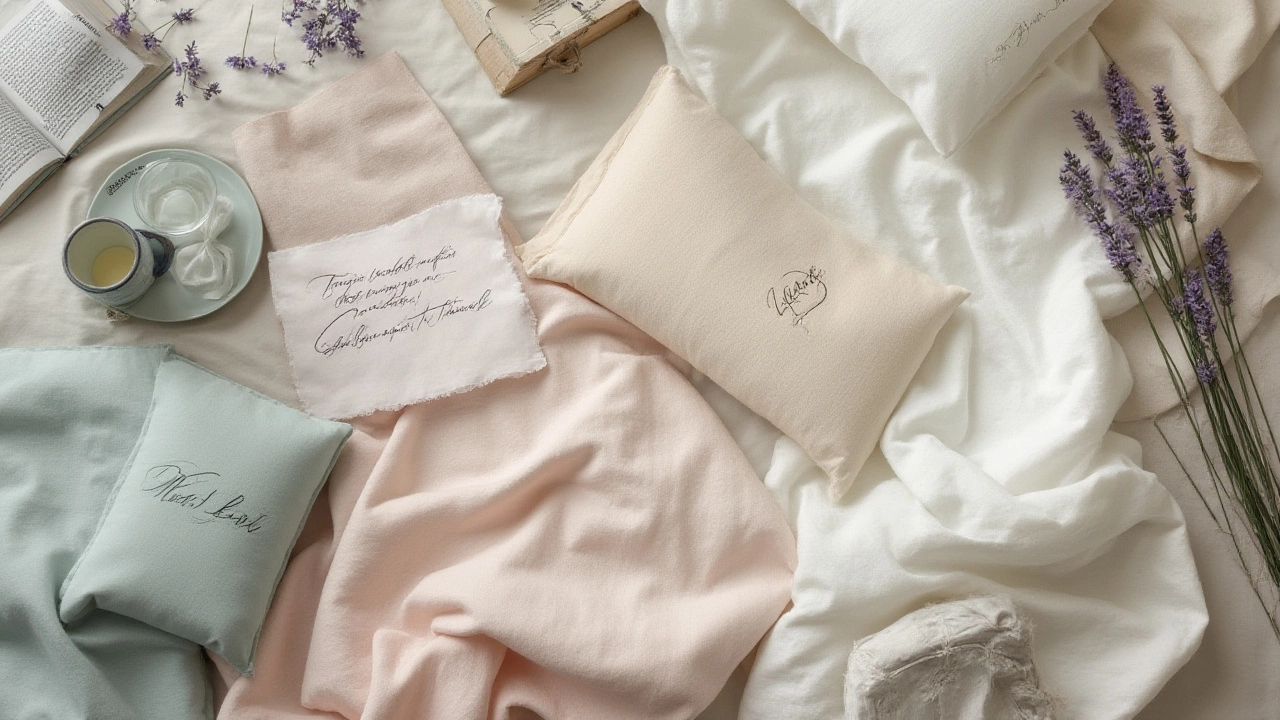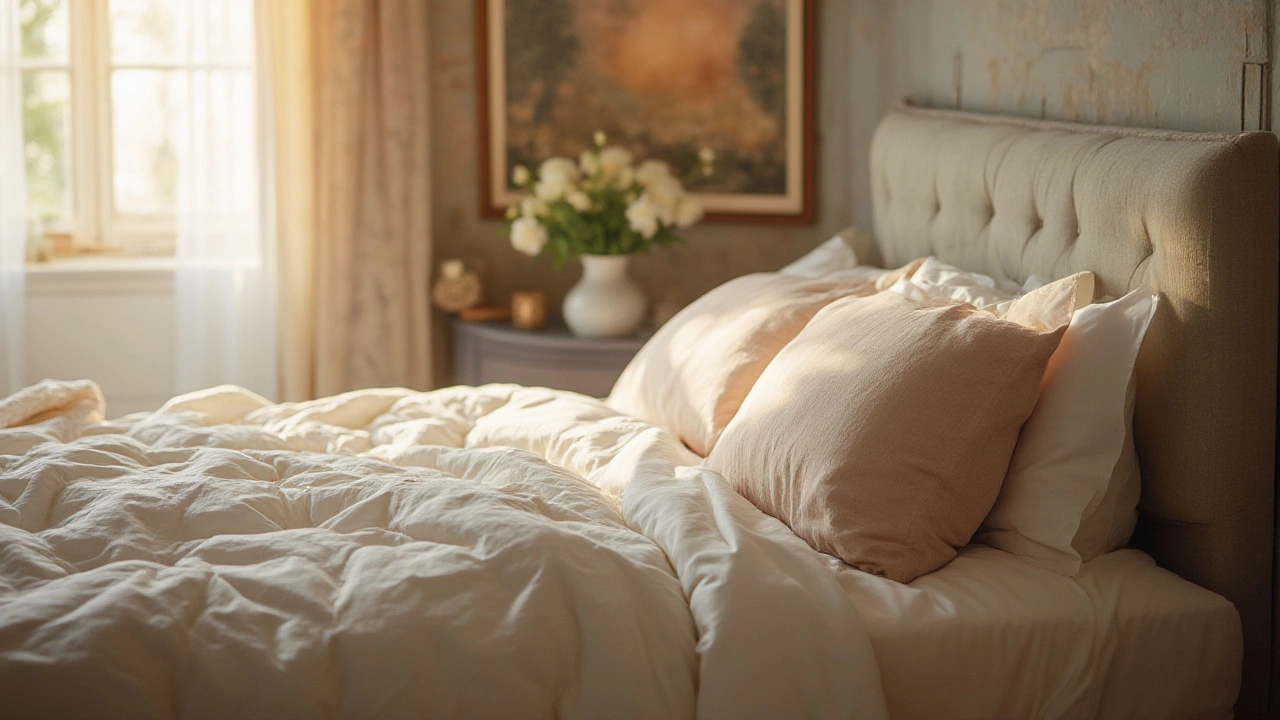Picture this: You slip into bed after a long day, the sheets are cool and soft, and your comforter feels like a gentle hug. Sounds dreamy, right? Bedding is what makes all of that possible. Yet, walk into a home store, and you’ll see endless rows of things labeled as bedding, from sheets to throws to toppers with names in foreign languages or fancy packaging. So, what exactly is meant by "bedding"? It's way more than just a sheet tossed over your mattress.
Defining Bedding: More Than Just Sheets
Bedding is a catch-all term for the removable layers that go on top of your mattress, and it’s not just a blanket and a pillow. Officially, bedding includes any linens or textiles meant for sleep—think sheets, pillowcases, blankets, duvets, comforters, quilts, bedspreads, mattress protectors, even decorative shams. Historically, bedding started as simple woven cloth. The oldest evidence of bedding comes from a South African cave, where sleeping mats made of grass and leaves dated back 200,000 years have been found—who knew our love affair with comfy beds went back so far?
The modern idea of bedding really picked up steam during the Renaissance in Europe, when people started layering feather beds, quilts, and more elaborate coverings—proof that a desire for comfort can get pretty fancy. Today, the bedding industry is massive. According to industry stats, North American consumers spent over $11 billion on bedding in 2023 alone, with an average person owning at least three full sheet sets. Bedding has grown beyond necessity; it’s also a key decor element for expressiveness and self-care.
But wait, here’s a twist: ever wondered why hotel beds feel so much, well, better? It’s not just cleanliness. Hotels typically use high-thread-count cotton, layered flat sheets, and smooth mattress pads—all parts of the bedding equation. And there’s a science to it, too. Gentler bedding materials are linked to better sleep, and switching to a fresh set of sheets can measurably enhance how quickly you drift off.
The Building Blocks of Bedding: What Do You Really Need?
Walk through any big-box store, and even a simple bed seems to need a pile of products. Here’s a real breakdown of what “bedding” covers, and what you really ought to have on your bed:
- Sheets: The workhorses. Typically, this means a fitted sheet (with elastic corners to hug your mattress), a flat/top sheet, and pillowcases. Cotton reigns supreme, but there’s demand for linen, bamboo, Tencel, and microfiber—each with pros and cons for feel, cooling, and budget.
- Blankets & Comforters: The warmth givers. This is everything that piles up for coziness—quilts, duvets, fleece throws, and synthetic or down-filled comforters. The terms can overlap: in the US, a comforter is usually a thick, quilted blanket, while in the UK, “duvet” means the quilted insert and “duvet cover” is the decorative, washable case.
- Mattress Toppers/Protectors: These aren’t glamorous, but they extend mattress life, keep out dust mites, and trap sweat or spills. A soft topper adds extra cushioning, and protectors are a must for allergy-prone folks.
- Pillows & Shams: Basic pillowcases are bedding, but decorative shams add texture and style. There are over ten types of pillows on the market, from ergonomic memory foam to down blends.
- Bedspreads & Decorative Layers: These often get called “coverlets,” “throws,” or “bed runners.” They don’t add much warmth but make a bed look polished—think hotel-style layering.
Here’s a quick table breaking down bedding essentials:
| Item | Main Purpose | Care Tip | Material Varieties |
|---|---|---|---|
| Fitted Sheet | Protects mattress & provides sleeping surface | Wash weekly | Cotton, Linen, Bamboo, Microfiber |
| Flat Sheet | Barrier between you & blanket/duvet | Wash weekly | Cotton, Percale, Sateen |
| Pillowcase | Protects pillow, comfort for face | Change twice a week | Cotton, Satin, Silk |
| Blanket/Comforter | Warmth, weight | Wash every 2-3 months | Down, Synthetic, Wool, Fleece |
| Duvet Cover | Decor, allows easy laundering | Wash monthly | Cotton, Linen, Microfiber |
| Mattress Protector | Blocks spills, allergens | Wash monthly | Polyester, Waterproof blends |
If you’re on a budget, the most important bits are a fitted sheet, a basic blanket or comforter, and two pillowcases that feel good on your face. Even these can transform how your sleep feels, and investing in one nicer item (say, a smooth cotton duvet cover) is often worth it for the experience.

Bedding Materials: What You Touch Really Matters
Shopping for bedding can be overwhelming—thread count, Egyptian cotton, percale, sateen, microfiber, and now things like bamboo and eucalyptus blends. What’s best? The answer depends on your skin sensitivity, what climate you live in, and your personal preferences for texture. Cotton is the classic: it’s breathable, durable, and gets softer with every wash. High-quality cotton bedding, especially long-staple varieties like Egyptian or Supima, gets rave reviews for a reason—these fibers resist pilling and keep their structure.
If you sweat at night, consider percale (a crisp, matte weave) or linen, which are the go-tos for hot sleepers. Linen is naturally cool, yet temperature-regulating for chilly winters. Don’t be surprised by wrinkles—wrinkling is normal for linen and percale, and many people appreciate the “lived-in” look. Satin and silk pillowcases are popular for those who want less friction on hair and skin (sleeping on silk really can reduce morning frizz and sleep wrinkles, and that’s actually been tested by hair stylists and dermatologists!).
Microfiber is often more affordable and resists wrinkles, but it’s less breathable. Bamboo and eucalyptus fiber bedding are growing in popularity for their silky feel and natural moisture-wicking properties—especially if you have sensitive skin or environmental concerns. Keep in mind, some so-called “bamboo” sheets are technically rayon, processed with chemicals; opt for brands that use closed-loop manufacturing if sustainability matters to you. Weighted blankets, another bedding trend, can help with anxiety and insomnia but need covers that are easy to remove and wash.
Certain bedding fabrics can make a surprising difference in allergies. For example, dust mites can’t thrive as easily in tightly woven microfiber, and hypoallergenic down alternatives are everywhere now. If you deal with allergies, check for bedding labeled “OEKO-TEX certified,” which means it’s been tested for harmful chemicals—an easy way to spot sheets that won’t irritate sensitive skin.
Choosing, Caring For, and Updating Your Bedding
So, how do you pick the right bedding? Start by thinking about how you sleep. Are you warm or cold at night? If you get hot, stick to lightweight, breathable materials—percale cotton or linen sheets make a huge difference. If you always pile on the blankets, try a down alternative comforter or a plush duvet insert. Next, consider how much time you’ll want to spend on care. Busy parents or students may be better off with wrinkle-resistant sheets and machine-washable quilts rather than high-maintenance fabrics.
Don’t just grab the first duvet cover you see. Patterned bedding can hide stains or pet hair. Light colors look airy, but they show every mark unless you’re diligent about laundry. Mixing and matching textiles is more forgiving—pair a solid colored sheet set with a boldly patterned duvet cover, or vice versa, if you like some variety. Try adding a throw blanket at the foot of the bed in a rich color or soft texture for an instant style boost without too much cost. Some stylists suggest refreshing your main set of sheets every 1-2 years—fibers break down faster than we realize, and nothing beats the feeling of brand-new bedding.
Let’s get real: laundry matters. You’ll want a routine. Aim to wash your pillowcases twice a week, sheets weekly, and duvet covers monthly (unless there are allergies or pets). Always use a gentle detergent and skip the bleach, which shortens the life of your bedding. Dryer balls (or even clean tennis balls) can help keep comforters fluffy if you tumble-dry them. Got tough stains? Spot-treat quickly, but avoid harsh chemicals if your bedding is delicate or colored.
Bedding isn’t just a practical thing; it can be your mood-lifter. Studies from sleep labs (like the one at the University of Oxford in 2021) show that changing your bedding actually leads to immediate improvements in well-being and relaxation—even if your mattress is older. And remember, “bedding” picks up trends, too. Right now, earthy tones, relaxed linens, bold color blocking, and layered monochrome looks are everywhere on Instagram and Pinterest. Treat bedding as a small luxury that pays off every single night, and you’ll start seeing your own bed as the best spot in the house.

